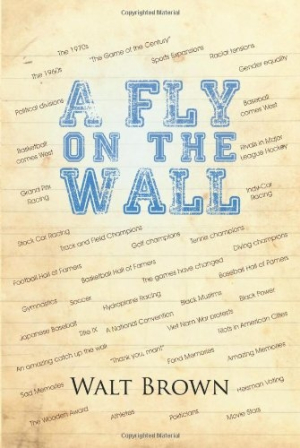A Fly on the Wall
Brown offers an engaging play-by-play of the celebrity athletes he has met over the course of his career.
In a bar full of guys trading sports stories, Walt Brown is the one with the best tales to tell. The retired play-by-play man and radio and television sportscaster has compiled decades’ worth of stories into A Fly on the Wall.
In fact, the book flows very much like a long conversation, bouncing from topic to topic at a rapid pace, with the mention of one topic often inspiring the introduction of new names to the story. Early on, Brown notes that he is often asked to name the most impressive athletes or celebrities he has met. That question was the impetus for the book, and the unveiling of his top five—Muhammad Ali, Jesse Owens, Gary Player, Rod Laver, and Stan Musial—is a tool used to progress the narrative.
Short tales of crossing paths with those “most impressive” athletes include interesting nuggets of information. Describing the interactions would give away too much, but Brown is right when he notes a Phoenix television station failed to capture “what would have been one of the great Ali videos of all time” when a videographer failed to turn on his camera. There’s considerably more meat to other stories, like one about a reticent college basketball star facing pressure to be more visible in the Black Power movement on campus who sought counsel from Brown. The recounting of a racially motivated minor league baseball brawl and the botched investigation that followed is also an intriguing story. Among what could have remained untold is Brown putting Willie Mays and Marcus Allen atop his Pantheon of nude locker room figures: “Among thousands of undressed athletes, only two seemed surreal, ‘out of body art.’”
As much as A Fly on the Wall is a collection of short stories about the celebrities Brown met during his career, it’s also an autobiography of his own long career in radio and television. While a national audience may prefer more of the former and less of the latter, former loyal Brown viewers and listeners in markets like Phoenix, Seattle, and Lincoln, NE, may take interest in the circumstances and decisions (some his own, others not) behind his career path.
The book isn’t strictly focused on athletes. Brown includes his behind-the-scenes perspective on how John F. Kennedy’s staff recruited and coached supporters at the 1960 Democratic National Convention, as well as interactions with entertainers Bob Hope, Mickey Rooney, George C. Scott, and others outside the sporting world.
This engaging book could be improved with some strong editing to correct its handful of grammatical errors—the most egregious of which is the constant misspelling of Muhammad Ali’s first name—and organize its content into a more reader-friendly format. With its extra-large type size, the book is well suited to be a quick read, but it could be made more accessible by arranging celebrity interactions in a more digestible manner, rather than weaving them in and out of a long narrative and breaking out dozens of strangely placed vignettes; for instance, in the midst of the story about the college basketball player, Brown relays how he came up with his home run call for his baseball play-by-play duties.
As is, readers need to dig a bit through A Fly on the Wall to mine the jewels that Brown has to share. Fortunately, there are many worth searching for in this book.
Reviewed by
Rich Rezler
Disclosure: This article is not an endorsement, but a review. The publisher of this book provided free copies of the book and paid a small fee to have their book reviewed by a professional reviewer. Foreword Reviews and Clarion Reviews make no guarantee that the publisher will receive a positive review. Foreword Magazine, Inc. is disclosing this in accordance with the Federal Trade Commission’s 16 CFR, Part 255.

